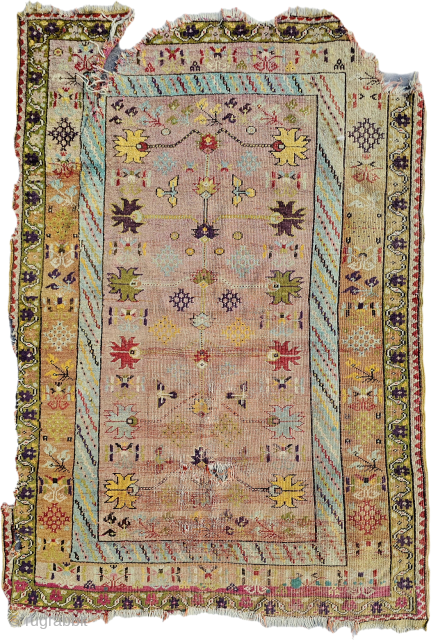Back
Size ; 115 x 150 cm
Central anatolia, Cappadocia
The term "Mecidi" or "Mecidiye" style takes its name from the period of the Ottoman Sultan Abdülmecid (1839-1861). This period was a time of intense Westernization and modernization in the Ottoman Empire, beginning with the Tanzimat Edict.
Western Influence (Rococo/Baroque): This Westernization also influenced the arts. Traditional, angular, and geometric Anatolian motifs gradually gave way to more curvilinear, floral designs reminiscent of European "Baroque" or "Rococo" styles.
Motifs: The stylized flowers scattered on the pale pink field, the branches emerging from vases or bouquets, and the flowing borders in the piece you sent are typical features of this "Mecidi style." It represents a more "urban" and "palace-inspired" aesthetic, different from the stark geometry of traditional village rugs.
Centers: These carpets were mostly woven in important Central Anatolian carpet-weaving centers such as Kırşehir, Mucur, Kayseri, and Sivas. "Mecidi Kırşehir" or "Mecidi Mucur" prayer rugs are among the most well-known examples of this style.
price:
Ask
- Home
- Antique Rugs by Region
- Category
- Profiles
- Post Items Free
- Albums
- Benaki Museum of Islamic Art
- Budapest: Ottoman Carpets
- Gulbenkian Museum
- Islamic Carpets. Brooklyn
- Islamic Textiles. Brooklyn
- Konya Museum: Rugs
- MKG, Hamburg
- MMA: Caucasian Carpets
- MMA: Mamluk Carpets
- MMA: Mughal Indian Carpets
- MMA: Ottoman Carpets
- MMA: Safavid Persian Carpets
- MMA: Turkmen Rugs
- McCoy Jones Kilims
- Ottoman textiles. Met
- Philadelphia Museum
- Rugs and Carpets: Berlin
- Seljuqs at the Met
- TIEM, Istanbul: Carpets
- V&A: Classical Carpets
- Vakiflar Carpets: Istanbul
- Baluch Rugs: Indianapolis
- Gallery Exhibitions
- Jaf an Exhibition
- Alberto Levi Gallery
- Andean Textile
- Christie's London: 2016
- Francesca Galloway
- HALI at 40
- ICOC Washington, DC 2018
- Jajims of the Shahsavan
- London Islamic Week April, 2018
- Mongolian Felts
- Navajo Rugs: JB Moore
- Persian Piled Weavings
- SF Tribal & Textile Art Show 2020
- SF Tribal 2019
- Sotheby's: C. Alexander
- Turkish Prayer Rugs
- Turkmen Main Carpets ICOC 2007










